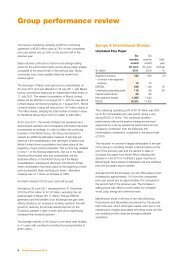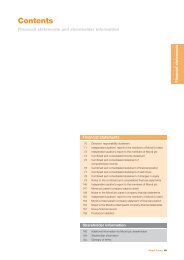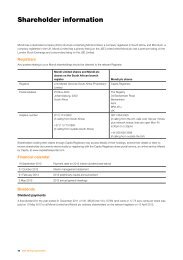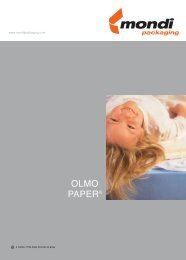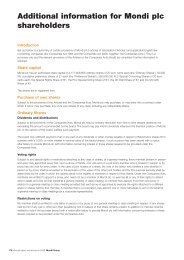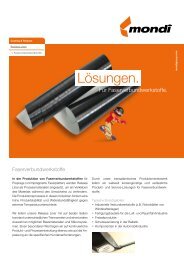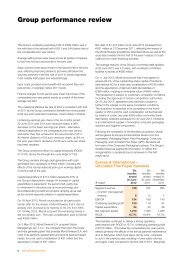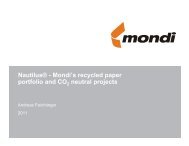Notes to the combined and consolidated financial statements - Mondi
Notes to the combined and consolidated financial statements - Mondi
Notes to the combined and consolidated financial statements - Mondi
Create successful ePaper yourself
Turn your PDF publications into a flip-book with our unique Google optimized e-Paper software.
<strong>Notes</strong> <strong>to</strong> <strong>the</strong> <strong>combined</strong> <strong>and</strong><br />
<strong>consolidated</strong> <strong>financial</strong> <strong>statements</strong> continued<br />
for <strong>the</strong> year ended 31 December 2009<br />
1 Accounting policies (continued)<br />
Deferred tax liabilities are recognised for taxable temporary differences arising on investments in subsidiaries, joint ventures <strong>and</strong><br />
associates, except where <strong>the</strong> Group is able <strong>to</strong> control <strong>the</strong> reversal of <strong>the</strong> temporary difference <strong>and</strong> it is probable that <strong>the</strong> temporary<br />
difference will not reverse in <strong>the</strong> foreseeable future.<br />
The carrying amount of deferred tax assets is reviewed at each reporting date <strong>and</strong> is adjusted <strong>to</strong> <strong>the</strong> extent that it is no longer<br />
probable that sufficient taxable profit will be available <strong>to</strong> allow all or part of <strong>the</strong> asset <strong>to</strong> be recovered.<br />
Deferred tax is calculated at <strong>the</strong> tax rates that are expected <strong>to</strong> apply in <strong>the</strong> year when <strong>the</strong> liability is settled or <strong>the</strong> asset is realised.<br />
Deferred tax is charged or credited in <strong>the</strong> <strong>combined</strong> <strong>and</strong> <strong>consolidated</strong> income statement, except when it relates <strong>to</strong> items charged<br />
or credited directly <strong>to</strong> equity, in which case <strong>the</strong> deferred tax is also taken directly <strong>to</strong> equity.<br />
Deferred tax assets <strong>and</strong> liabilities are offset when <strong>the</strong>y relate <strong>to</strong> income taxes levied by <strong>the</strong> same tax authority <strong>and</strong> <strong>the</strong> Group<br />
intends <strong>to</strong> settle its current tax assets <strong>and</strong> liabilities on a net basis.<br />
Leases<br />
Leases are classified as finance leases whenever <strong>the</strong> terms of <strong>the</strong> lease transfer substantially all <strong>the</strong> risks <strong>and</strong> rewards of ownership<br />
<strong>to</strong> <strong>the</strong> lessee. All o<strong>the</strong>r leases are classified as operating leases.<br />
Operating leases<br />
Rental costs under operating leases are charged <strong>to</strong> <strong>the</strong> <strong>combined</strong> <strong>and</strong> <strong>consolidated</strong> income statement in equal annual amounts<br />
over <strong>the</strong> lease term.<br />
Finance leases<br />
Assets held under finance leases are recognised as assets of <strong>the</strong> Group on inception of <strong>the</strong> lease at <strong>the</strong> lower of fair value or <strong>the</strong><br />
present value of <strong>the</strong> minimum lease payments derived by discounting at <strong>the</strong> interest rate implicit in <strong>the</strong> lease. The interest element<br />
of <strong>the</strong> rental is charged against profit so as <strong>to</strong> produce a constant yearly rate of interest on <strong>the</strong> remaining balance of <strong>the</strong> liability,<br />
unless it is directly attributable <strong>to</strong> qualifying assets, in which case it is capitalised in accordance with <strong>the</strong> Group’s general policy on<br />
borrowing costs.<br />
Provisions<br />
Provisions are recognised when <strong>the</strong> Group has a present obligation as a result of a past event, <strong>and</strong> it is probable that <strong>the</strong> Group<br />
will be required <strong>to</strong> settle that obligation. Provisions are measured at management’s best estimate of <strong>the</strong> expenditure required <strong>to</strong><br />
settle <strong>the</strong> obligation at <strong>the</strong> reporting date, <strong>and</strong> are discounted <strong>to</strong> present value where <strong>the</strong> effect is material.<br />
Res<strong>to</strong>ration, decommissioning <strong>and</strong> environmental costs<br />
An obligation <strong>to</strong> incur res<strong>to</strong>ration <strong>and</strong> environmental costs arises when environmental disturbance is caused by <strong>the</strong> development or<br />
ongoing production of a plant or l<strong>and</strong>fill site. Such costs arising from <strong>the</strong> installation of plant <strong>and</strong> o<strong>the</strong>r site preparation work,<br />
discounted <strong>to</strong> <strong>the</strong>ir present value, are provided for <strong>and</strong> capitalised at <strong>the</strong> start of each project, or as soon as <strong>the</strong> obligation <strong>to</strong> incur<br />
such costs arises. These costs are charged against profit over <strong>the</strong> life of <strong>the</strong> operation, through <strong>the</strong> depreciation of <strong>the</strong> asset <strong>and</strong><br />
<strong>the</strong> unwinding of <strong>the</strong> discount on <strong>the</strong> provision. Costs for res<strong>to</strong>ration of subsequent site damage which is created on an ongoing<br />
basis during production are provided for at <strong>the</strong>ir present values <strong>and</strong> charged against profits as <strong>the</strong> obligation arises.<br />
Changes in <strong>the</strong> measurement of a liability relating <strong>to</strong> <strong>the</strong> decommissioning of plant or o<strong>the</strong>r site preparation work that result from<br />
changes in <strong>the</strong> estimated timing or amount of <strong>the</strong> cash flow, or a change in <strong>the</strong> discount rate, are added <strong>to</strong>, or deducted from, <strong>the</strong><br />
cost of <strong>the</strong> related asset in <strong>the</strong> current year. If a decrease in <strong>the</strong> liability exceeds <strong>the</strong> carrying amount of <strong>the</strong> asset, <strong>the</strong> excess is<br />
recognised immediately in <strong>the</strong> <strong>combined</strong> <strong>and</strong> <strong>consolidated</strong> income statement. If <strong>the</strong> asset value is increased <strong>and</strong> <strong>the</strong>re is an<br />
indication that <strong>the</strong> revised carrying value is not recoverable, an impairment test is performed in accordance with <strong>the</strong> accounting<br />
policy for impairment testing.<br />
Government grants<br />
Government grants relating <strong>to</strong> capital expenditure projects are treated as deferred income <strong>and</strong> released <strong>to</strong> <strong>the</strong> <strong>combined</strong> <strong>and</strong><br />
<strong>consolidated</strong> income statement over <strong>the</strong> expected useful lives of <strong>the</strong> assets for which <strong>the</strong> government grants are provided.<br />
90 Annual report <strong>and</strong> accounts 2009 <strong>Mondi</strong> Group



